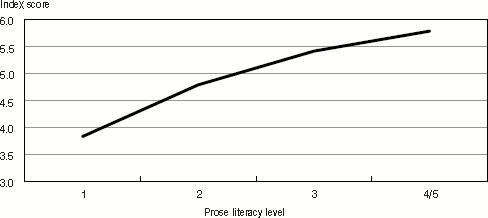
Results displayed in Figure 5.6 also indicate that prose literacy proficiency increases with the use of computers for task-oriented purposes. The findings are similar for the other two ICT indices developed for this study as well as for the other competency domains measured in the IALSS. These results are consistent with another study that suggests that adults with high literacy and numeracy proficiency perform better in an assessment of ICT skills than adults with low literacy and numeracy (DfES, 2003).
Figure 5.6
Source: International Adult Literacy and Skills Survey, 2003.
Age is known from previous research studies to be a major factor in the use of ICTs. Generally, younger adults use ICTs more frequently and more intensely than older adults. The IALSS findings confirm this general pattern. Values on all three ICT indices are found to decline steadily with increasing age, with the largest decrease observed for the group aged 56 to 65 years. Many of the items included in the index measuring the use of computers for task-oriented purposes are associated with work tasks, such as writing or editing text, managing accounts or spreadsheets, programming, creating presentations and keeping a schedule or calendar. The steep decline in the index score observed for those aged 56 to 65 indicates that older individuals and persons in early retirement do not perform these tasks as regularly as younger age groups. The relationship between age and the index of diversity and intensity of Internet use is also strong. In contrast, the relationship between age and the index of perceived usefulness of computers is weaker.